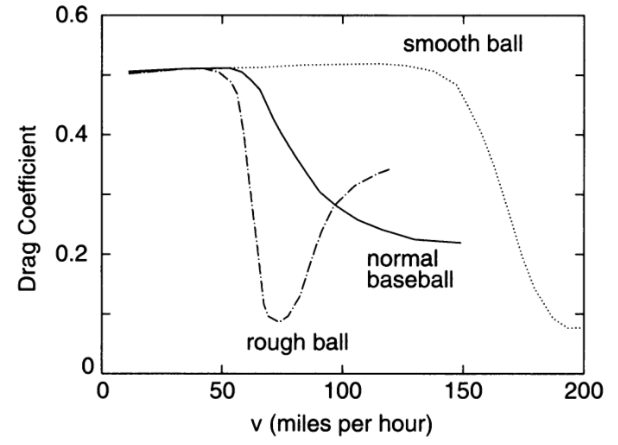@zy-0815
2016-10-23T14:05:56.000000Z
字数 9011
阅读 1692
张梓桐计算物理第六次作业
1.Problem
2.10
2.Abstract
In this passage,we are going to discuss the track of a cannon shell with adbiatic effect and wind resistance(headwind,or tailwind).Additionally,a calculation of minimun velocity with regard to a specific target is presented too.
3.Background Introduction
With the previous knowledge of Euler Method,we don't have to illustrate again the basic knowledge.What is of great importance to us is the additional wind resistance.Here we set the velocity of wind to be ,and the veloocity of cannon to be .
The components of the drag force can be represented as:
Noticing that the drag coefficient regarding to the velocity of cannon is presented in the follow figure.

The analyatic form of can be expressed as:
Here and are constant, and .
On top of that,there will be a effect of adbiatic air effect with regard to the altitude:
In the situation of adbiatic effect:
which means there will be a additional coefficient plus the wind resistance force.
Having discussed all of the concerning factors,we finally deduce the core calculation equation:
4.Main body
4.1 The track of the cannon shell.
import mathimport pylab as pla=1class cannon:def __init__(self,intial_velocity,intial_angle,velocity_of_wind,angle_of_wind):#Variable that can be set#self.x=[0]self.y=[0]time_step=0.01mass=10intial_vx=intial_velocity*math.cos(int(intial_angle)*math.pi/180)intial_vy=intial_velocity*math.sin(int(intial_angle)*math.pi/180)self.vx=[intial_vx]self.vy=[intial_vy]self.v=[math.sqrt(intial_vx**2+intial_vy**2)]self.dt=time_stepself.intial_angle=intial_angleself.m=massself.angle_of_wind=angle_of_windself.velocity_of_wind=velocity_of_windself.B2=[self.m*(0.0039+0.0058/(1+math.exp((self.v[0]-35)/5)))]self.delta_v_mold=[math.sqrt((intial_vx-self.velocity_of_wind*math.cos(self.angle_of_wind*math.pi/180))**2+(intial_vy-self.velocity_of_wind*math.sin(self.angle_of_wind*math.pi/180))**2)]def run(self):i=0while self.y[i]>=0:self.B2.append(self.m*(0.0039+0.0058/(1+math.exp((self.v[i]-35)/5))))self.v.append(math.sqrt(abs(self.vx[i])**2+abs(self.vy[i])**2))self.delta_v_mold.append(math.sqrt((self.vx[i]-abs(self.velocity_of_wind*math.cos(self.angle_of_wind*math.pi/180)))**2+(self.vy[i]-self.velocity_of_wind*math.sin(self.angle_of_wind*math.pi/180))**2))self.x.append(self.x[i]+self.vx[i]*self.dt)self.y.append(self.y[i]+self.vy[i]*self.dt)self.vx.append(self.vx[i]-pow(1-0.0065*self.y[i]/273,2.5)*self.B2[i]*self.delta_v_mold[i]*(self.vx[i]-self.velocity_of_wind*math.cos(self.angle_of_wind*math.pi/180))/self.m*self.dt)self.vy.append(self.vy[i]-10*self.dt-pow(1-0.0065*self.y[i]/273,2.5)*self.B2[i]*self.delta_v_mold[i]*(self.vy[i]-self.velocity_of_wind*math.sin(self.angle_of_wind*math.pi/180))/self.m*self.dt)i+=1self.x[-1]=(self.x[-1] * self.y[-2] - self.x[-2] * self.y[-1])/ (self.y[-2] - self.y[-1])figure_2.png-74.6kBdef show(self):pl.plot(self.x,self.y,label='$\\theta=$'+str(self.intial_angle)+'$^{\circ}$'+'.x='+str(int(self.x[-1]))+',Wind velocity '+str(self.velocity_of_wind)+'\n'+'Angle of wind is '+str(self.angle_of_wind)+'$^{\circ}$')pl.ylim(0,300)pl.xlim(0,400)pl.xlabel('x(m)')pl.ylabel('y(m)')pl.show()pl.legend(fontsize='xx-small')class show_trajectory_of_various_angle(cannon):def run2(self):theta=0while theta<90:a=cannon(intial_angle=theta,intial_velocity=110,velocity_of_wind=10,angle_of_wind=135)theta+=1a.run()a.show()class show_trajectory_of_various_wind_velocity(cannon):def run3(self):v=0while v<30:b=cannon(intial_velocity=110,intial_angle=45,velocity_of_wind=v,angle_of_wind=135)v+=1b.run()b.show()class show_trajectory_of_various_angle_of_wind(cannon):def run4(self):theta2=45while theta2 in [45,135]:c=cannon(intial_velocity=244,angle_of_wind=theta2,intial_angle=35,velocity_of_wind=22.27)theta2+=135c.run()c.show()a=show_trajectory_of_various_angle(110,45,10,135)a.run2()
4.2 Find the minimun firing velocity
import mathimport pylab as plimport timea=1class cannon:def __init__(self,intial_velocity,intial_angle,velocity_of_wind,angle_of_wind):#Variable that can be set#self.x=[0]self.y=[0]time_step=0.01mass=10intial_vx=intial_velocity*math.cos(int(intial_angle)*math.pi/180)intial_vy=intial_velocity*math.sin(int(intial_angle)*math.pi/180)self.vx=[intial_vx]self.vy=[intial_vy]self.v=[math.sqrt(intial_vx**2+intial_vy**2)]self.dt=time_stepself.intial_angle=intial_angleself.m=massself.angle_of_wind=angle_of_windself.velocity_of_wind=velocity_of_windself.B2=[self.m*(0.0039+0.0058/(1+math.exp((self.v[0]-35)/5)))]self.delta_v_mold=[math.sqrt((intial_vx-self.velocity_of_wind*math.cos(self.angle_of_wind*math.pi/180))**2+(intial_vy-self.velocity_of_wind*math.sin(self.angle_of_wind*math.pi/180))**2)]def run(self):i=0while self.y[i]>=-100:self.B2.append(self.m*(0.0039+0.0058/(1+math.exp((self.v[i]-35)/5))))self.v.append(math.sqrt(abs(self.vx[i])**2+abs(self.vy[i])**2))self.delta_v_mold.append(math.sqrt((self.vx[i]-abs(self.velocity_of_wind*math.cos(self.angle_of_wind*math.pi/180)))**2+(self.vy[i]-self.velocity_of_wind*math.sin(self.angle_of_wind*math.pi/180))**2))self.x.append(self.x[i]+self.vx[i]*self.dt)self.y.append(self.y[i]+self.vy[i]*self.dt)self.vx.append(self.vx[i]-pow(1-0.0065*self.y[i]/273,2.5)*self.B2[i]*self.delta_v_mold[i]*(self.vx[i]-self.velocity_of_wind*math.cos(self.angle_of_wind*math.pi/180))/self.m*self.dt)self.vy.append(self.vy[i]-10*self.dt-pow(1-0.0065*self.y[i]/273,2.5)*self.B2[i]*self.delta_v_mold[i]*(self.vy[i])/self.m*self.dt)i+=1self.x[-1]=((-100-self.y[-1])*(self.x[-1]-self.x[-2])/(self.y[-1]-self.y[-2]))+self.x[-1]self.y[-1]=-100global aa=self.x[-1]def show(self):pl.plot(self.x,self.y,'r',label='$\\theta=$'+str(self.intial_angle)+'$^{\circ}$'+'.x='+str(int(self.x[-1]))+',Wind velocity '+str(self.velocity_of_wind)+'\n'+'Angle of wind is '+str(self.angle_of_wind)+'$^{\circ}$')pl.ylim(-100,300)pl.xlabel('x(m)')pl.ylabel('y(m)')pl.show()pl.legend(fontsize='xx-small')class find_spot(cannon):object_x=220object_y=-100def run4(self):v=67.7230while 67.7230<=v<68:theta2=14.99while 14.99<=theta2<20:c=cannon(intial_velocity=v,angle_of_wind=135,intial_angle=theta2,velocity_of_wind=10)c.run()if 220>a:theta2+=0.0001else:print theta2,'degree',a,'m',v,'m/s'breakv+=0.00001if 220<a:breaka=find_spot(110,45,10,135)a.run4()
5.Track Result
5.1 Result with different intial angles
Here we set the intial velocity all to be .The angle of wind is (headwind),and the velocity of wind is
Now we change the intial firing angles from with

As this figure is not too compact and difficult to distinguish,we now set

Here we can see,around ,the land point reachs max.
Now we take a closer look at around .

Here we can see, at around ,the land point reaches the maxium.And .

5.2 Results with different wind angles
Here we set the intial velocity all to be .The angle of wind is (from tailwind to headwind),,and the velocity of wind is .Intial angles is .

Here we can see,as the angles of wind is changed from tailwind to headwind, the land point is shifting left,which means reach a lesser distance.
To illustrate the difference with or withoud wind,I am going to attach another figure.The angle of wind is and

This figure corresponds well to our feeling in our life!
5.3 Results with different velocity of wind
Here we set the intial velocity all to be .The angle of wind is (headwind),and the velocity of wind is ,. Intial angles is .

As the wind velocity is becoming larger and larger,there may be situation where the cannon shell is blown back.
6.Find the target
In this section,we are going to discuss about how to fire a cannon shell with the minimun velocity to reach the target.At first,we set the objec to be set in ,which means the target is lower than the firing places.
However,when we are about to set the scanning interval of and velocity with and .The time taken by the calculation is too long.For compromising,we set the and to identify the mighty intervals,and we find around and velocity about is the ideal result.
Step by step,we narrow the section and finally finds out that at and ,the velocity reaches the minmum.

7.Acknowledgement
1.Yu kang has helped with the find-spot programming.
2.Matplotlib.
